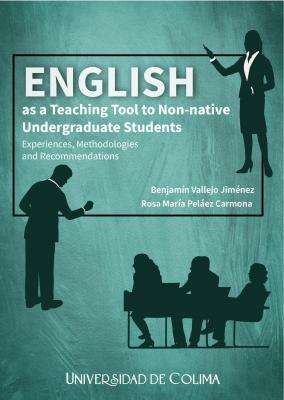English as a Teaching Tool to Non-native Undergraduate Students: Experiences, Methodologies and Recommendations
Keywords:
English Medium Instruction, Curriculum design, Teaching strategiesSynopsis
The book is the outcome of an initiative by professors teaching in English, focusing on the implications of transitioning from a native language teaching system to a non-native language educational experience. It addresses higher education stakeholders, particularly university presidents, administrators, and professors involved in or interested in English Medium Instruction (EMI) programs. The book is divided into three sections: Institutional approaches towards curricular internationalization, EMI, and Teaching strategies and conditions. The authors draw from experiences in Mexican institutions like the University of Colima, University of Puebla, and the University of the Caribbean, as well as contributions from non-Mexican professors.
Downloads
References
Bralić, A. & Divjak, B. (2018). Integrating MOOCs in Traditionally Taught Courses: Achieving Learning Outcomes with Blended Learning. International Journal of Educational Technology in Higher Education, 15(2): 1-16 https://doi.org/10.1186/s41239-017-0085-7
Coursera (2014). Introduction to Sustainability. Retrieved from: https://www.coursera.org/learn/sustainability
Danek, D. & Hertzfeld, B. (2019). 2030: How MOOCs Overcame Criticism. Retrieved from: https://ohiostate.pressbooks.pub/6223ebook2019/chapter/chapter-7-moocs/
edX (2015). Circular Economy: An Introduction. Retrieved from: https://www.edx.org/es/course/circular-economy-an-introduction
Griffiths, R.J.; Mulhern, C.; Spies, R. & Chingos, M.M. (2015). Adopting MOOCs on Campus: A Collaborative Effort to Test MOOCs on Campuses of the University System of Maryland. Online Learning. https://doi.org/10.24059/olj.v19i2.523
Haber, J. (2014). MOOCs. MIT Press. https://doi.org/10.7551/mitpress/10120.001.0001
Hashim, H.U. & Yunus, M.M. (2019). Digital Learning with Massive Open Online Courses (MOOCs): English for Communication. Modern Journal of Language Teaching Methods (MJLTM), 9(3) https://doi.org/10.26655/mjltm.2019.3.3
Herman, R.L. (2012). Letter from the Editor-in-Chief: The MOOCs Are Coming. The Journal of Effective Teaching, 12(2): 1-3. https://doi.org/10.1002/mus.22219
Hornby, A.S.; Lea, D. & Bradbery, J. (2020). Oxford Advanced Learner's Dictionary (10th ed.). Oxford University Press.
Instituto Nacional de Estadística y Geografía (INEGI) (2021). Comunicado de Prensa, núm. 351/21. Retrieved from: https://www.inegi.org.mx/contenidos/saladeprensa/boletines/2021/OtrTemEcon/ENDUTIH_2020.pdf
Instituto Nacional de Estadística y Geografía (INEGI) (2020). Quintana Roo. Número de habitantes por municipio. Retrieved from: http://cuentame.inegi.org.mx/monografias/informacion/qroo/poblacion/
Laaser, W. (2014). The Rise and Fall of the Massively Open Online Courses. South Eastern European Journal of Public Health, 3: 1-13
Malliga, P. (2013). A Survey on MOOC Providers For Higher Education. International Journal of Management & Information Technology, 7(1):962-967. https://doi.org/10.24297/ijmit.v7i1.713
Obrist, M. & Jansen, D. (2019). Existing MOOC Business Models. BizMOOC- Knowledge Alliance to Enable a European-wide Exploitation of the Potential of MOOCs for the World of Business. Retrieved from: https://bizmooc.eu/papers/business-models/?print=print
Pappano, L. (2012). The Year of the MOOC. The New York Times. Retrieved form: https://www.nytimes.com/2012/11/04/education/edlife/massive-open-online-courses-are-multiplying-at-a-rapid-pace.html
Rusli, R.; Umiera Hashim, H.; Hashim, H. & Yunus, M. (2019). Learners' Awareness Towards the Use of MOOCs in Teaching and Learning. Creative Education, 10: 3012-3019 https://doi.org/10.4236/ce.2019.1012225
Shea, M. (2015). MOOC: A University Qualification in 24 Hours? The Skinny - Independent Cultural Journalism. Retrieved from: https://www.theskinny.co.uk/tech/features/moocs
Sparke, M. (2016). Situated Cyborg Knowledge in Not so Borderless Online Global Education: Mapping the Geosocial Landscape of a MOOC. Geopolitics, 22(1): 51-72 https://doi.org/10.1080/14650045.2016.1204601
Universidad del Caribe (2021). Oferta Educativa y Nuestra Universidad. Universidad del Caribe. Retrieved from: https://www.unicaribe.mx/
Yale University (2012). Open Yale Courses. Philosophy and the Science of Human Nature. Retrieved from: https://oyc.yale.edu/philosophy/phil-181

Downloads
Published
Series
Categories
License

This work is licensed under a Creative Commons Attribution-NonCommercial-ShareAlike 4.0 International License.







